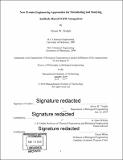| dc.contributor.advisor | K. Dane Wittrup. | en_US |
| dc.contributor.author | Tisdale, Alison Wedekind. | en_US |
| dc.contributor.other | Massachusetts Institute of Technology. Department of Biological Engineering. | en_US |
| dc.date.accessioned | 2019-10-11T22:00:06Z | |
| dc.date.available | 2019-10-11T22:00:06Z | |
| dc.date.copyright | 2019 | en_US |
| dc.date.issued | 2019 | en_US |
| dc.identifier.uri | https://hdl.handle.net/1721.1/122521 | |
| dc.description | Thesis: Ph. D., Massachusetts Institute of Technology, Department of Biological Engineering, 2019 | en_US |
| dc.description | Cataloged from PDF version of thesis. | en_US |
| dc.description | Includes bibliographical references (pages 118-128). | en_US |
| dc.description.abstract | A variety of cancers are marked by the over-expression and over-activity of the EGF receptor (EGFR), rendering this protein an attractive therapeutic target. Anti-EGFR therapeutics are a mainstay of clinical practice for the treatment of colorectal, lung and head and neck cancers but efficacy is limited and response rates low. Opportunities for improving EGFR antagonism include higher potency inhibition of ligand binding, inducing receptor downregulation, or creating synergistic therapeutic combinations. The Wittrup lab has previously made significant advances in EGFR antagonism by demonstrating the therapeutic potential of inducing receptor downregulation through multi-epitopic targeting. The lab has also pioneered the use of a novel protein scaffold, called Sso7d, for yeast surface display-based libraries and selections. In the first part of this work I show that a combination of traditional yeast display techniques with simple but novel in silico approaches can be applied to derive a panel of Sso7d binders against EGFR with diverse paratopes. I demonstrate the superior EGFR inhibition of antibody-Sso7d fusions in vitro, and discuss the lessons learned from applying these proteins in vivo. In the second part of this work I use a structure-guided yeast display approach to create a novel research tool, a minimally modified verstion of cetuximab called "mCetux", which essentially enables in vivo experiments of cetuximab. I apply this antibody tool in vitro and in vivo in a new and highly relevant model system for colorectal cancer and subsequently discuss future opportunities for its use. | en_US |
| dc.description.sponsorship | Funded by NIH/NIGMS Biotechnology Training Grant | en_US |
| dc.description.statementofresponsibility | by Alison W. Tisdale. | en_US |
| dc.format.extent | 141 pages | en_US |
| dc.language.iso | eng | en_US |
| dc.publisher | Massachusetts Institute of Technology | en_US |
| dc.rights | MIT theses are protected by copyright. They may be viewed, downloaded, or printed from this source but further reproduction or distribution in any format is prohibited without written permission. | en_US |
| dc.rights.uri | http://dspace.mit.edu/handle/1721.1/7582 | en_US |
| dc.subject | Biological Engineering. | en_US |
| dc.title | New protein engineering approaches for potentiating and studying antibody-based EGFR antagonism | en_US |
| dc.type | Thesis | en_US |
| dc.description.degree | Ph. D. | en_US |
| dc.contributor.department | Massachusetts Institute of Technology. Department of Biological Engineering | en_US |
| dc.identifier.oclc | 1121455567 | en_US |
| dc.description.collection | Ph.D. Massachusetts Institute of Technology, Department of Biological Engineering | en_US |
| dspace.imported | 2019-10-11T22:00:05Z | en_US |
| mit.thesis.degree | Doctoral | en_US |
| mit.thesis.department | BioEng | en_US |
